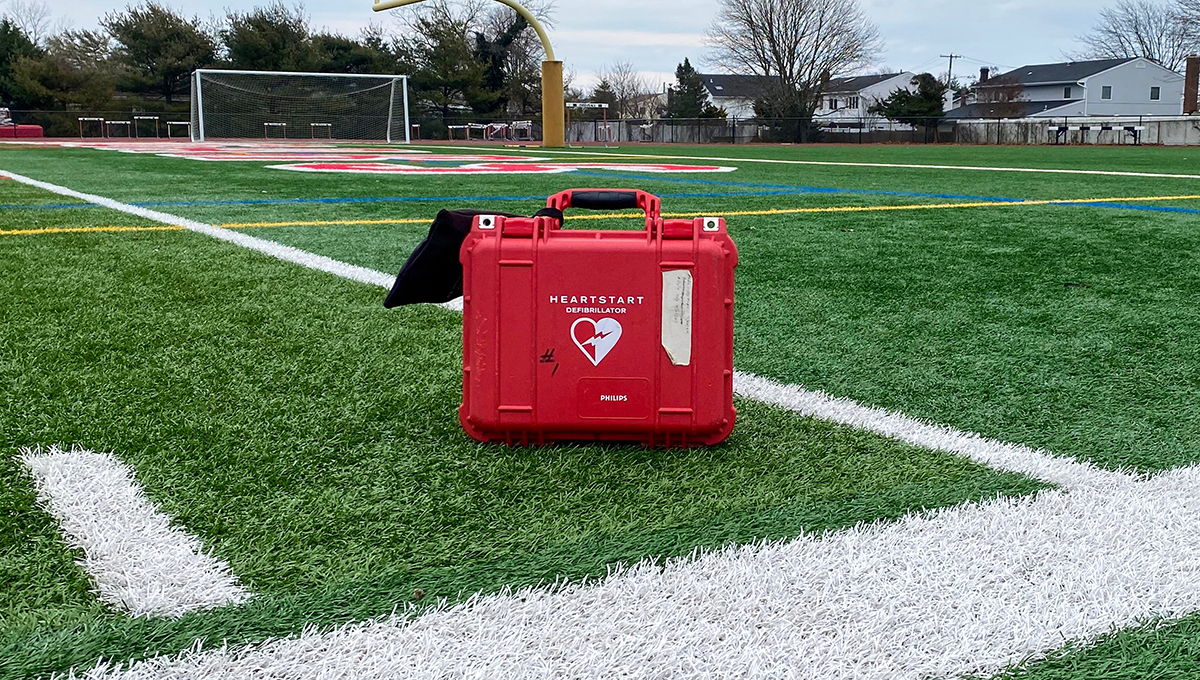
More than 50% survived to discharge, which investigators attribute to high rates of bystander-initiated CPR and AED use.
The risk of sudden cardiac arrest (SCA) during recreational sports is small, but when an event does occur, more than 50% of people can survive to hospital discharge, suggests new research from Canada.
The findings highlight the importance of initiating cardiopulmonary resuscitation (CPR) and/or using an automated external defibrillator (AED), say researchers. Bystanders performed CPR in more than three-quarters of the athletes who suffered a sports-related SCA and used an AED to deliver a shock in more than one-third of cases.
Katherine Allan, PhD (Unity Health Toronto, Canada),who led the study along with Mika’il Visanji, BHSc (McMaster University, Hamilton, Canada), said the good news is that when a cardiac arrest occurs in public, such as hockey arenas, gyms, or community centers, “for the most part, it really gets a high response rate from people around them,” she told TCTMD.
Both Allan and senior investigator Paul Dorian, MD (Unity Health Toronto), emphasized that their study revealed SCA happens infrequently in those playing in sports, despite the outsized publicity and media attention that occurs when an athlete, particularly a high-profile one such as Bronny James or Damar Hamlin, has an event. As their data show, sports-related SCA is much more likely to occur in male, middle-aged athletes.
“As a general rule, it’s not that common,” said Dorian. “You shouldn’t be afraid of doing sport, because it is pretty rare.”
Matthew Martinez, MD (Atlantic Health System, Morristown, NJ), a member of the American College of Cardiology’s sport and exercise cardiology leadership council, said the study provides a comprehensive look at the incidence of sports-related SCA, noting that it included a wide age range of recreational athletes.
“AEDs are the most important tool when you’re managing cardiac arrest,” Martinez told TCTMD. The study, he added, is a reminder of the importance of educating the public about lifesaving first aid, including CPR and AED use, as well in as making access to AEDs more widely available in the community.
C-SCAN Analysis
The retrospective cohort study, which was published last week in the Canadian Journal of Cardiology, included data collected from the Canadian Sudden Cardiac Arrest Network (C-SCAN). Sports-related SCA in British Columbia, Alberta, Saskatchewan, Ontario, Quebec, and Nova Scotia was categorized based on the type of activity: racket sports, winter sports, ball sports, home and/or gym workouts, water sports, hockey, exercise classes, and other, such as hiking and ultimate frisbee, among others.
Between, 2016 and 2020, there were 18,557 sudden cardiac arrests in adults aged 18 to 85 years, of which 339 occurred during sports or within an hour of stopping. The incidence of sports-related SCA was 1.2 events per 100,000 person-years, but it was more than 16-fold higher in men than in women (2.3 vs 0.2 events per 100,000 person-years). When stratified by age, the incidence was 0.3, 1.4, and 2.3 in those 18-34 years, 35-64 years, and 65-85 years, respectively.
More than three-quarters of arrests were witnessed, and bystanders used the AED in 36.1% of SCAs. CPR was performed in 73.6% of cases. The arrests occurred in 52 unique sports, most frequently in hockey (n = 58), cycling, (n = 56), running/jogging (n = 43), ball sports such as soccer or basketball (n = 41), and working out (n = 41).
SCAs that were bystander witnessed, witnessed by emergency medical services (EMS), or involved bystander use of AEDs were all significantly associated with improved odds of survival to hospital discharge, as were having a shockable rhythm and the arrest occurring in a public place.
“If you look at everyone, not in the context of sports, most of the time AEDs are only used 2% to 3% of the time,” said Allan. “It’s quite disappointing. So, this was really exciting to see that people are actually using them when [the sudden cardiac arrest] happens in those public spaces or community centers.”
Survival after SCA in the community is estimated to be less than 10%, with bystanders initiating CPR in roughly 40% of patients, according to the American Heart Association.
“It has a lot to do with the location of where these events are happening,” said Allan, referring to the high survival seen among recreational athletes. “They are mostly happening in public and recreational facilities. There’s lots of eyes on the people potentially, so they’re more likely to be witnessed if they go down. Oftentimes, at least at gyms or [places like that], the staff might be trained, and they don’t have to wait [for EMS].”
Dorian also stressed the importance of older men and women speaking with their doctor before jumping back into sports. The majority of hockey players in Canada are middle-aged men playing recreationally, he said, adding that many of these older athletes might be unaware of subclinical heart disease. He also emphasized the value of knowing where an AED is located and how to use it.
Martinez stressed athletes aren’t immune from cardiovascular disease, and that precautions should be taken as people age. “If you’re exercising, and you’re in an older group, make sure you’re doing it in a safe environment, and make sure you’ve at least had the discussion with what to do if something happens,” added Martinez.
With more than 50% of recreational athletes surviving to hospital discharge, Dorian said the results are excellent but added that they’d like to see survival rates exceed 60% or 70% over time.



